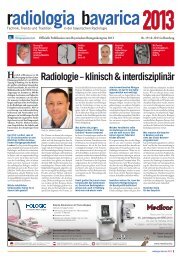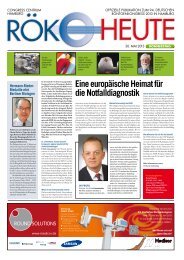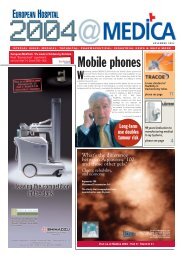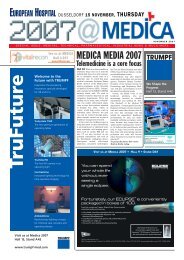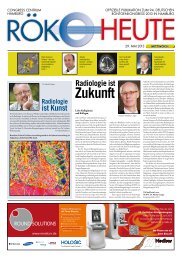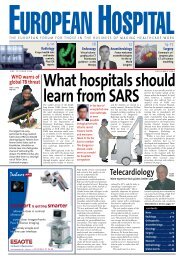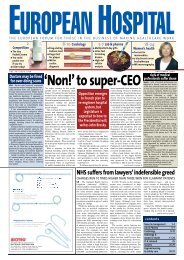PET scanning the heart cuts costs - European-Hospital
PET scanning the heart cuts costs - European-Hospital
PET scanning the heart cuts costs - European-Hospital
Create successful ePaper yourself
Turn your PDF publications into a flip-book with our unique Google optimized e-Paper software.
UK - The NHS in England* is a<br />
complex environment, with over<br />
50 million potential patients, 1.2<br />
million staff, 14 million transactions<br />
in a typical week, 10,000<br />
component organisations, and<br />
over 60 Royal Colleges and bodies.<br />
(*Scotland has a separate<br />
organisation).<br />
As reported in previous issues of<br />
<strong>European</strong> <strong>Hospital</strong>, back in 1998<br />
<strong>the</strong> NHS unveiled its strategy to<br />
modernise its IT Systems to help<br />
improve services back, and in<br />
2002 <strong>the</strong> Government set up <strong>the</strong><br />
National Programme for IT<br />
(NPfIT) in England, with £2.3 billion<br />
to be invested over its first<br />
three years, which have now<br />
ended.<br />
The plan intends to connect over<br />
30,000 general practitioners (GP)<br />
Fig. 1 National Application Service Providers (NASP’s) are responsible for buying and integrating IT systems to be used<br />
nationally, such as <strong>the</strong> NHS Care Records Service<br />
Service Contract Contractor Value Period<br />
NHS Care Records Service BT £620m 10 years<br />
Choose and Book (E-booking) Atos Origin (formerly SchlumbergerSema £65m 5 years<br />
N3 (<strong>the</strong> New National Network) BT will act as a system integrator to buy connections from<br />
a constantly updated set of approved national and local<br />
telecoms companies<br />
BT Syntegra for new software to manage information and<br />
payments under <strong>the</strong> Quality and Outcomes Framework<br />
Broadband Network + BT £530m 7 years<br />
Fig 2. Local Service Providers (LSPs) are based around five regions, formed from ‘clusters’ of strategic health authorities.<br />
The five regional clusters are: London, North East, Sou<strong>the</strong>rn, Eastern and North West & West Midlands. LSPs are responsible<br />
for delivering IT systems and services to be used locally. Local Service Provider (LSP) contracts have been awarded to:<br />
Service Contract Contractor Value Period<br />
LSP, London Capital Care Alliance, led by BT £996m 10 years<br />
LSP, East of England Accenture £934m 10 years<br />
LSP, North East + LSP North West Accenture £1099m 10 years<br />
LSP, West Midlands The CSC Alliance £973m 10 years<br />
LSP, South The Fujitsu Alliance £896m 10 years<br />
IT & TELEMEDICINE<br />
It is one of <strong>the</strong> world’s biggest investments in IT for healthcare. But what will it really cost? Report by Peter Howieson<br />
The NPfIT<br />
to almost 300 hospitals; give<br />
patients access to <strong>the</strong>ir personal<br />
healthcare data, and transform <strong>the</strong><br />
way <strong>the</strong> NHS works. Information<br />
is expected to move around quicker<br />
with healthcare records,<br />
appointment details, prescription<br />
information, and up-to-date<br />
research into illnesses and treatment<br />
accessible to patients and<br />
health professionals whenever<br />
needed. The plan also intends to<br />
support individual choices,<br />
enabling first hospital outpatient<br />
appointments to be made at a<br />
time, date and place to suit <strong>the</strong><br />
patient. As planned, <strong>the</strong> NPfIT<br />
was to be rolled out in four phases<br />
over a period of eight years: April<br />
2002 to December 2010.<br />
When <strong>the</strong> National Programme<br />
has run it course, it should have<br />
delivered:<br />
● An Information and<br />
Communication Technology (ICT)<br />
structure to provide secure and<br />
high-speed communications<br />
between users, as well as supporting<br />
<strong>the</strong> necessary infrastructure to<br />
provide telemedicine services.<br />
● A National Booking Service for<br />
online booking for all patient<br />
appointments.<br />
● A National Prescription Service<br />
for electronic prescriptions with<br />
full clinical and patient support.<br />
● An NHS Care Records Service<br />
(NHS CRS) which would also<br />
manage both <strong>the</strong> National<br />
Booking Service and <strong>the</strong> National<br />
Prescription Service<br />
In May 2004 <strong>the</strong> Government earmarked<br />
£2.3 billion for <strong>the</strong> next<br />
three-year period, to include <strong>the</strong><br />
cost of buying new systems and<br />
<strong>the</strong> training and education needed<br />
to help staff to adapt to new ways<br />
of working. Funding for future<br />
years will be handled as part of<br />
<strong>the</strong> Government’s annual spending<br />
review. The total value of contracts<br />
awarded (covering 7-10<br />
years) is over £6 billion. Fur<strong>the</strong>r<br />
central funding will be needed to<br />
cover supplier contracts for <strong>the</strong>ir<br />
10-year lifetime. However, central<br />
funding will not cover all aspects<br />
of <strong>the</strong> NPfIT’s delivery, but it is<br />
not yet clear what proportion of<br />
funding will need to be found<br />
locally. Currently <strong>the</strong> NHS spends<br />
around £850m annually, primarily<br />
locally, on IT systems and <strong>the</strong>ir<br />
support. On top of this, funding<br />
for <strong>the</strong> NPfIT will require<br />
£370m in 2003/4<br />
£730m in 2004/5<br />
£1.2 billion in 2005/6<br />
The new systems will be implemented<br />
by groups of commercial<br />
suppliers - known as National<br />
Application Service Providers<br />
(NASPs) and Local Service<br />
Providers (LSPs) - which will work<br />
toge<strong>the</strong>r (see figures 1 & 2).<br />
The new National Network,<br />
which replaces <strong>the</strong> private NHS<br />
communications network NHSnet,<br />
will be of higher capacity and will<br />
provide fast, broadband networking<br />
services to <strong>the</strong> NHS making it<br />
possible to deliver <strong>the</strong> reforms and<br />
new services including electronic<br />
transmission of prescriptions, and<br />
picture archiving and communication<br />
systems (PACS).<br />
In January 2004, a NHS-wide<br />
agreement - <strong>the</strong> first of a series<br />
that <strong>the</strong> NPfIT is negotiating with<br />
IT suppliers - was made with <strong>the</strong><br />
Oracle Corp for <strong>the</strong> NHS to consolidate<br />
and standardise on a single,<br />
secure, resilient database infrastructure.<br />
Already a key IT supplier<br />
to <strong>the</strong> NHS, Oracle’s involvement<br />
has now increased as a result<br />
of <strong>the</strong> recent NHS Care Record<br />
contract awards, in which <strong>the</strong> firm<br />
is a sub-contractor to a number of<br />
<strong>the</strong> LSPs. They are supplying <strong>the</strong><br />
infrastructure that will underpin<br />
<strong>the</strong> NHS Care Records Service,<br />
which will provide all over 50 million<br />
patients with an individual<br />
electronic NHS Care Record<br />
detailing key treatments and care<br />
within ei<strong>the</strong>r <strong>the</strong> NHS or social<br />
care. It is estimated that, from<br />
2008, this infrastructure will deal<br />
with up to five billion transactions<br />
annually.<br />
Connections to <strong>the</strong> new ‘N3’<br />
network began in April 2004 and,<br />
in 2007, it is expected that <strong>the</strong><br />
18,000 sites that deliver healthcare<br />
in England will be linked electronically<br />
for <strong>the</strong> first time. This will<br />
include <strong>the</strong> migration of 10,000<br />
sites with current NHSnet connections<br />
over to N3. Priorities for this<br />
migration will be based on a variety<br />
of factors including LSP needs;<br />
when current connection contracts<br />
expire, and potential savings that<br />
can be made in each location.<br />
Formal procurement began in<br />
January 2003. As well as <strong>the</strong><br />
prime contractor, <strong>the</strong> role of sub-<br />
contractors will be key, with a<br />
number of subcontractors involved<br />
in more than one service.<br />
As reported in <strong>European</strong><br />
<strong>Hospital</strong>, in May 2004 Eastman<br />
Kodak Company’s Health Imaging<br />
Group was selected as one of <strong>the</strong><br />
digital solutions suppliers for <strong>the</strong><br />
NHS NPfIT. Kodak is part of an<br />
alliance led by Computer Sciences<br />
Corporation (Capital Care<br />
Alliance). The system will feature:<br />
● Computed Radiography (CR)<br />
machines that enable physicians to<br />
capture x-ray images digitally<br />
● A PACS to store and distribute<br />
radiology images<br />
● A Radiology Information System<br />
(RIS) to manage all information<br />
stored in <strong>the</strong> PACS.<br />
As seen in figure 2, Accenture<br />
won <strong>the</strong> (December 2005) two<br />
LSP contracts for <strong>the</strong> North East<br />
and Eastern regional clusters, with<br />
a combined value of c. £2 billion.<br />
In February this year, Accenture<br />
signed up four new IT suppliers, to<br />
assist with <strong>the</strong> IT infrastructure in<br />
those clusters:<br />
Cognos will supply ReportNet, a<br />
web services-based reporting tool,<br />
to assess disease trends, bed availability<br />
and waiting lists.<br />
EMC Documentum will supply<br />
a platform of content management<br />
services, to provide quick/easy<br />
access to a wide range of content<br />
and documents including X-rays,<br />
doctors’ notes and research material.<br />
First DataBank Europe will provide<br />
software to warn of potential<br />
adverse effects of drugs at <strong>the</strong><br />
point of care (POC).<br />
Informatica software will be<br />
used to enable faster/easier access<br />
to various legacy systems that<br />
track patient data for <strong>the</strong> electronic<br />
care records system.<br />
However, sounding a negative<br />
note in February this year, Mike<br />
McGrath, chief financial officer of<br />
Accenture, said <strong>the</strong> scale of problems<br />
with its NHS government<br />
How did an ICU reduce<br />
patient complications<br />
and ventilation hours,<br />
while saving $US 4.5<br />
million per year?<br />
Find out in Critical Care News.<br />
contract had now reached a magnitude<br />
where <strong>the</strong>y had to be<br />
revealed to <strong>the</strong> market. There<br />
had been delays in deployment of<br />
a new assessment care system, he<br />
said, and talks were now taking<br />
place with <strong>the</strong> NHS on different<br />
deployment plans. Losses of<br />
$110m to $150m were expected<br />
on <strong>the</strong> contract in <strong>the</strong> current fiscal<br />
year and losses would continue<br />
at a lesser level in 2006.<br />
However, be added that <strong>the</strong> contract<br />
was expected to turn <strong>the</strong><br />
corner and start to become profitable<br />
in 2007.<br />
Get your free copy. To register your interest<br />
go to www.criticalcarenews.com<br />
EUROPEAN HOSPITAL Vol 14 Issue 2/05 21



